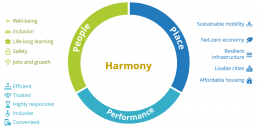People, Place and Performance in Harmony
Citizen trust in governments grew to an all-time high in 2020 in many European countries during the COVID-19 pandemic. This trust in public institutions enabled governments to respond rapidly and to plan an inclusive recovery. Of course, average government expenditure as a percentage of gross domestic product (GDP) also peaked in 2020 across the 27 EU Member States — from 49.1% in 2011 to 53.1% in 2020, according to Eurostat.
Quantum government is being accelerated by the pandemic, and a combination of climate change and heavy investment are offering European governments a once-in-a-century opportunity to deliver on the promises of competitive net-zero economies and places, high-performing public administrations, and people empowerment and well-being.
The public sector is betting the farm on digital transformation. Public sector leaders need to turn data into valuable insights and drive harmonious societal impact by delivering empathic customer experiences that make bureaucracy invisible, intelligent automation capabilities that make civil servants productive, and trusted data sharing that fosters innovation, while protecting digital sovereignty.
Priming the Future of Public Services
The question is no longer whether governments should invest in technology-enabled innovation or if they can afford to make those investments. The pressure to get results is higher than ever. Taxpayers expect governments to realise the benefits of investing critical public funds in digital and data. European government leaders that want to get this right should consider five critical success factors and must:
- Align their technology innovation to strategic, long-term PURPOSE. This will bring down organisational barriers and converge IT, business and policy competencies to drive impact where it matters. When the city of Vaasa started to build a platform to help it go carbon neutral, it had to gather data from its three biggest carbon emission sources — transportation, heating and electricity consumption — by integrating data generated by hospitals, schools, transportation and residential heating. The integration of these strategic datasets aimed to create a digital twin of the city’s CO2 emissions that it could use to simulate the impact of measures, such as dropping temperatures in schools by one degree or organising a car-free day. The convergence of efforts of so many stakeholders happened because everyone understood the need to waste no time to reduce CO2 emissions.
- Build technology solutions and organisations that are modular, agile and RESILIENT to short-term shocks and long-term changes. When Mumbai was hit by severe flooding in 2017, the city’s CCTV cameras, installed by the police to monitor traffic violations and other safety risks, were a critical asset in helping the rescue of people stranded because of the extreme weather.
- Stretch their IMAGINATION to rethink existing processes and policies, instead of simply digitising the status quo. When HMRC decided to leverage the innovation happening in the open banking ecosystem, it did so to reimagine the typical revenue collection process, resulting in improved taxpayer convenience. The reimagined process made taxes payable in one click and improved internal efficiencies as HMRC now needs to deal with fewer errors and overdue payments.
- MASTER the operational, data and experience capabilities and capacities that can make a difference. When the province of South Tyrol launched a pilot project to use machine learning (ML) and satellite imaging to transform the process of awarding farming grants to rural communities in the complex Alpine environment, it was not content with standard ML methodologies. It augmented the expertise that it and its suppliers had by digging into thought-leading data science academic papers, so that it could test multiple models on different datasets and improve the accuracy of predictions. It also designed a cloud-based “as a service” operating model to scale the system.
- Engage the ECOSYSTEM. When NHS England wanted to expedite the vaccination campaign for unpaid carers, it partnered with the Department for Work and Pensions, which shared critical data such as carer allowance recipients, at scale and under strict security requirements, like never before.
Quantum Government Requires a Framework
Public sector leaders that embrace the PRIME (Purpose-Resilience-Imagination-Mastery-Ecosystem) principles will be able to implement an inclusive recovery that delivers on the promise of people, places and performance in harmony. Those that do not embrace PRIME will squander the unique opportunity offered by the convergence of the urgency to invest and the strength of citizen trust.
Join IDC experts and public sector leaders from around Europe at the IDC Government Summit to learn more about this quantum government transformation and to share your experiences.





